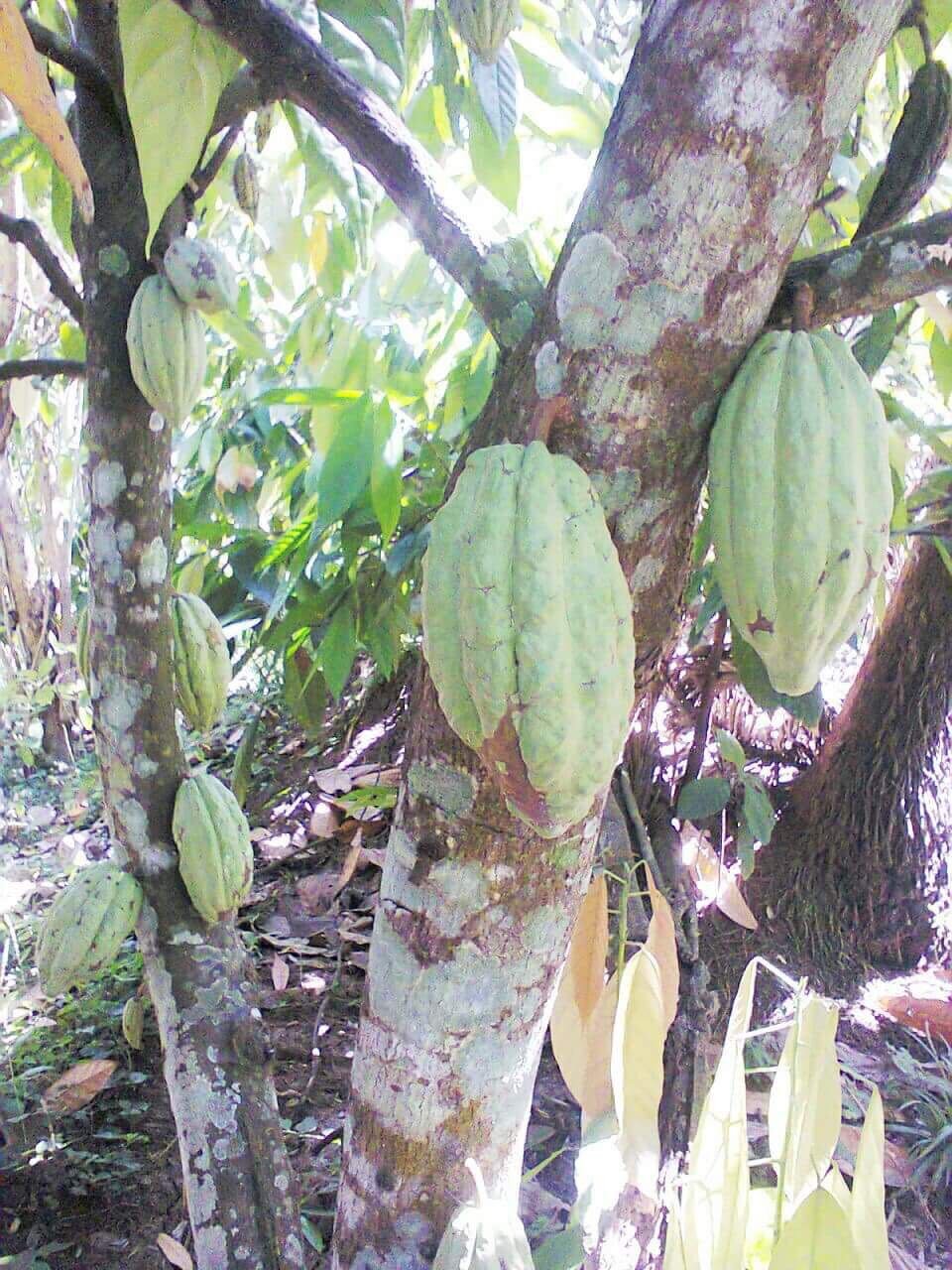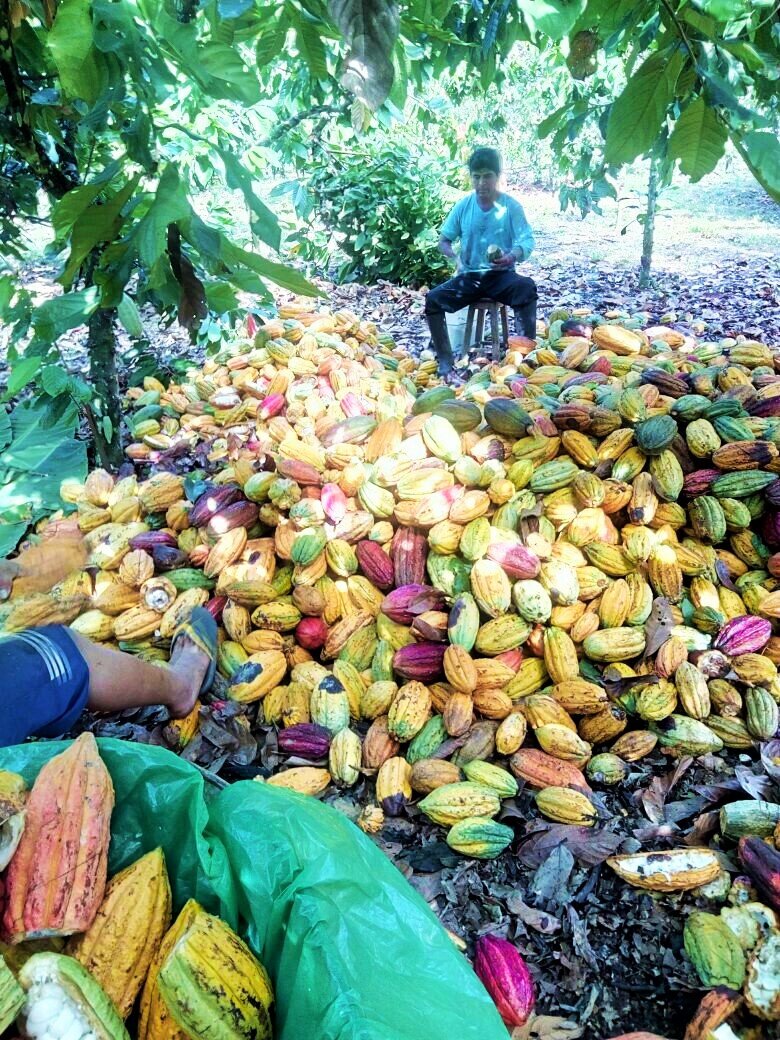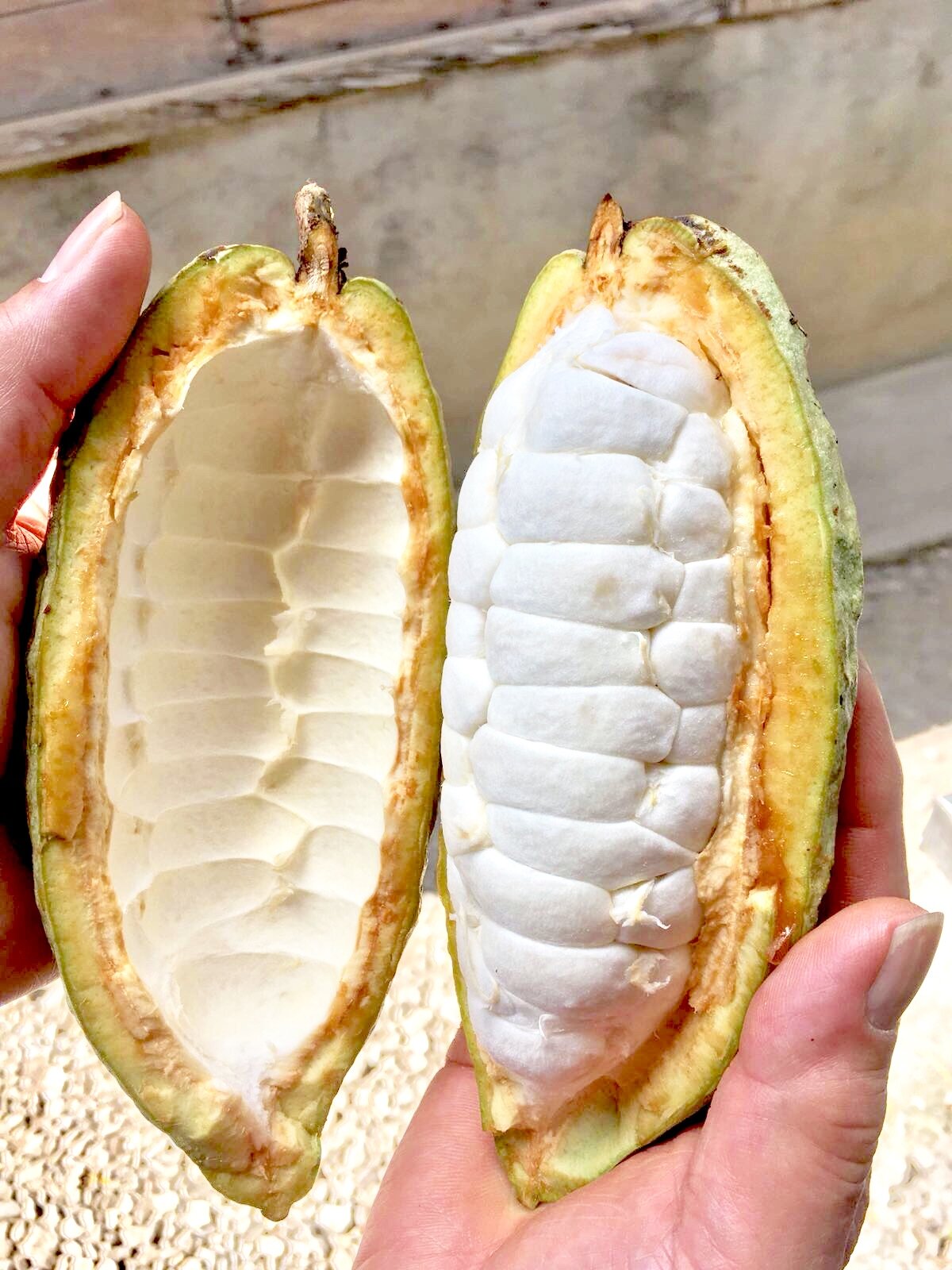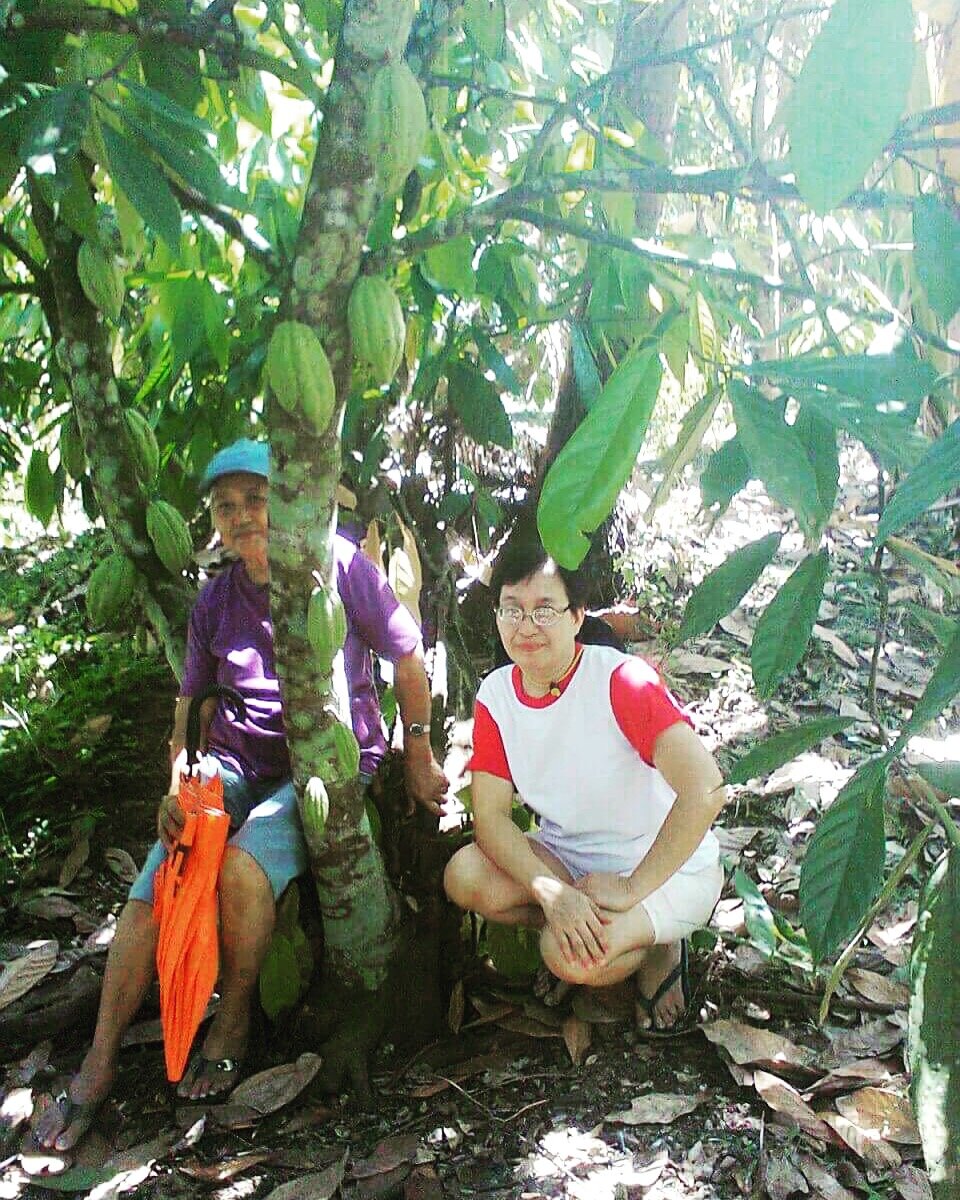Part 1
Part 3
Part 2: Cacao Growing & Curing
Harvesting, Fermentation, Drying
Cacao Growers
What role to the growers play in regards to flavour? This page will be updated as new information is received. Last edited August 15, 2022.
The growers impact many aspects of the cacao, which impact flavour in one way or another. These include, but are not limited to:
Terroir
Harvesting
Fermentation
Drying
Storage
+ Does terroir really impact the flavour of cacao?
It's believed that terroir plays an important role in the flavour of chocolate. Terroir explains the affect the environment (climate, terrain, soil, and interactions with other organisms) has on the characteristics of a plant during its development, in this case on the cacao bean. Terroir was first used to explain the effect of the environment on the flavour of wine. It wasn't until 1984 that it was used to describe chocolate. It's still not known if terroir carries the same truth for chocolate as it does for wine. Chocolate is not regulated to the same extent as wine, and the definition of terroir for chocolate is often loosely based, and largely unscientific. Bill Nesto (2010) explains this further.
Whatever the degree terroir plays on the final flavour of chocolate, the environment does seem to play a large role in altering the properties of the cacao seed and this is what will be discussed. We know this to be true for other botanicals as well. How much of an impact this has on the final flavour of the chocolate bar requires more research before we make any definite claims.
Geomorphology
Geomorphology deals with the terrain, or landscape, the cacao grows in. This can include the altitude, the geology, and surrounding features such as mountains, valleys, and bodies of water. There is not enough research in this area in regards to cacao. Since these features seem to apply to other crops, the same ideas can be hinted at towards cacao, but in what ways specifically remains to be discovered.
Climate
The climate alters the metabolism of the tree such as leaf flushing, the amount of flowers it produces, and the number and quality of pods that develop. Climate of where the trees grow seems to correlate to the properties of cocoa butter, such as the hardness or melting point and the the composition of the fatty acids. Cacao grown in a hotter climate will be composed of cocoa butter with a higher melting point than cacao grown in climates not quite as hot.
Although climate greatly affects cacao growth, health, and yield, successful links between climate and flavour of the cacao beans have yet to be made.
Soil
Soil pH, mineral levels, microbe life, moisture, depth, particle size, will all affect the growth and uptake of nutrients of cacao. However, pretty much all the research to date that deals with soil and cacao relate to yield and growth, and not flavour. We know from other studies, such as on tomatoes, that soil potassium has a logarithmic correlation with the acid content of the tomato (Davies and Winsor, 1967). As well, Increased Nitrogen and Potassium fertilization can have a negative effect on tomato flavour (Wright and Harris, 1985). There are likely similar correlations that can be made for nutrition uptake and cacao fruit and/or seed flavour, but more research is required before making any direct claims.
Interactions with other organisms
Intercropping T. cacao with shade trees is known to enhance growing conditions such as reducing wind and improving the nutrient cycling (Potassium, carbon, nitrogen) in the soil. As well, it allows the farmers to have a more diverse harvest and help supplement their income. Bai et al. (2017) observed that nutrient uptake in the soil correlated with the types plants intercropped with cacao, as well as their spacing. This is not a new practise, and in fact was practised in Mesoamerica before the European arrival.
It's safe to say that the effect humans have on cultivating their crops will affect the trees growth, and possibly the flavour of the cacao as well. Finding a balance of enough shade, sun, moisture, and nutrients are all aspects the farmers can control to a degree. How much shade they allow will affect how many flowers grow, how much foliage occurs, and the competition these have with the growing cacao pods for nutrients. Although again, not enough research has been made to connect these behaviours of farmers to the flavour of cacao, it's reasonable to assume that there may be a connection between these behaviours and cacao seed or fruit flavour.
A few behaviours that do affect flavour of cacao seeds is applied post-harvest. For instance, pods are sometimes held intact for days before opening, or a portion of the pulp is discarded before fermentation, which both are said to reduce acidity and "improve flavour" (whatever that means). Any introduced yeasts for fermentation the growers inoculate their cocoa mass with will also affect flavour, but this is performed post harvest.
+ What does picking cacao pods have to do with flavour?
Time of year & Harvest
Cacao pods take 5-6 months to mature. There are two main harvests throughout the year, but cacao trees will grow pods throughout the year. Pods which are harvested during the main harvests are said to be most flavourful. The pods contain the cacao seeds (AKA cacao beans) which are surrounded by a white fleshy fruit. The fruit and seeds are scooped out together and sent to the fermentation facility.
Some cacao growers will delay opening the pods for a few days or remove some of the juice/fruit before fermentation. This is said to reduce the acidification of the nib (cacao seed kernel) and possibly "increase the cocoa flavour".
Ripe cacao pods don't normally fall off on their own, and are carefully hand picked from the trees one by one. They are cut open one by one using a machete, and the fruit covered seeds are scooped out and sent to the fermentation facility. This is very labour intensive, as this part of the process is not mechanized.
During this process, the fruit had always been discarded and used for the fermentation process. However, today, some are trying to preserve some of this fruit, and turn it into juice for the consumer, putting more money into the pockets of farmers who harvest the juice along the way. Repurposed pod is one such manufacturer doing this with their farmers in Ecuador.
Ripeness
Picking cacao that is ripe will also affect the final flavour of the fruit, and this is important for the same reason mentioned above. Although there are two main harvests, the harvesting time usually lasts 2-3 months. As well, cacao is an evergreen, and will produce pods throughout the year. For this reason, it takes a great deal of manual labour to sift through the crop often and pick out the ripe pods before they spoil or get taken over by pests. In regions where growers are not paid much for their crop, often in regions where bulk cacao is grown, there is less incentive to wait until optimal ripeness. This may lead to off flavours and high levels of acidity or astringency.
Care
Harvesting is still done by hand. For over 5000 years, cacao is still harvested in a similar manner, with each pod being carefully taken off the tree by hand and cut open one by one. There is no mechanized way to collect cacao pods as there is for some other cash crops. If the seeds are accidentally sliced open, they have to be discarded, as they could mould and develop off flavours that may affect an entire batch of cacao seeds. This care that is required cuts into time and profits, a balance that's not always easy to achieve for some growers.
Pre fermentation preparation
Pulp pre-conditioning
This is the adjustment of the pulp before fermentation (Afoakwa et al., 2011b). Adjusting the level of moisture, the sugar content, the ratio of volume of pulp to seed, and PH will affect the flavour of the cocoa bean. Reducing the sugar content of the pulp has been shown to reduce the level of acids produced, resulting in less acidic beans. (Kongor et al., 2016).
Pod Storage
After picking the cocoa pods, they may be stored intact before opening them. Opening them would instantly induce fermentation. Studies have shown that delaying the fermentation of intact pods can reduce the nib acidification when they are finally fermented, as well as increase their cocoa flavour (Kongor et al., 2016).
+ Fermenting for future flavour
Introduction
Fermentation is the first step in processing that has major implications on the final flavour of chocolate. It's been said that fermentation allows for the precursor molecules of chocolate aroma molecules to develop. Without this step, the flavour of chocolate would not be achieved later during roasting. The most difficult task for the growers is the control of this fermentation process. Let's take a look at how different aspects of fermentation affect flavour.
Duration
The times vary depending on the preferences of the farmers or those at the fermentation facility. Knowing when to terminate fermentation often depends on experience, learning the smell, appearance, and temperatures of the fermenting mass. Generally, bulk cacao is fermented longer than very fine cacao. Fermentation greatly reduces bitterness and astringency which bulk cacao contains at higher levels.
Fermentation duration also depends on the properties of the beans, which often reflect variety and genetics. For instance, criollo often only takes a few days, since these seeds are less astringent. They contain procyanidin, which is a class of flavonoids which make the seeds appear ivory in colour.
"Forastero" on the other hand contains anthocyanins, which don't occur in criollo beans. Anthocyanins are a pigment found in plants that appear red, purple, or blue; likely why unfermented forastero beans appear purple, and why perhaps these beans are considered more astringent and dry as is red wine (which also contains high levels of anthocyanins). They usually take up to a week to ferment.
"Forastero" is used in much of the research on flavonoids instead of the suggested updated categories mentioned above. This research is more likely analyzing Amelonado, but I can't say with certainty.
Temperature
The correct temperature is important in order for the proper organisms and molecular reactions to occur. The mass of the fermentation heap is often between 45-50*C. This temperature also aids in killing the germ (or embryo) of the seed in the first couple days of fermentation.
The Players (organisms):
Multiple species of filamentous fungi, yeasts, lactic acid bacteria, acetic acid bacteria, and Bacillus species are the key players in fermentation of the cacao fruit pulp. Bacteria that are pathogenic and toxigenic haven't been identified during fermentation, probably due to high levels of acetic acid present.
Molds
The molds appear to be the first invaders. They, like Bacillus spp. which enter later on, produce the following enzymes:
- proteases (enzymes that breakdown proteins into amino acids and small polypeptides, which are important later during roasting)
- amylases (breaks down carbohydrates into simple sugars)
- and lipases (breaks down fats)
Products from number 1 and 2 will be important contributors to the Maillard reaction during roasting.
Yeasts
The pulp is rich in sugars (mostly glucose and fructose if ripe, or sucrose if unripe), which also allows yeasts to dominate the process for the first 12-48 hours. Yeasts include Saccharomyces, Candida, and Hanseniaspora to name a few. They perform many jobs including:
- Increasing the pH by removing citric acid (from a starting pH of about 3-3.5 as cacao fruit pulp can be quite acidic)
- Produce pectinolytic enzymes to breakdown the pulp, resulting in a more aerobic environment
- Produce ethanol (aids in killing germ)
- Produce organic acids (oxalate, succinate, malate, acetate)
- Produce volatile organic compounds (fusel alcohols, fatty acids, and fatty acid esters) which will later help to create the chocolate aroma
Yeasts are also said to produce large amounts of:
- isopropyl acetate
- ethyl acetate
- 1-propanol
- isoamyl alcohol
- 2,3-butanediol
- diethyl succinate
- phenylethanol which are considered desirable volatile compounds found in high quality chocolate and cocoa products.
Lactic Acid Bacteria (LACB)
The growth of lactic acid bacteria (Lactobacillus, Lactococcus, Leuconostoc) is initiated by steps 1 and 2 above during yeast growth. These LACB also produce ethanol. They consume glucose and citric acid from the pulp to create lactic acid. The greatest concentration of lactic acid can occur during day 5 of a 7 or 8 day fermentation.
Acetic Acid Bacteria (AAB)
Acetic acid bacteria (Acetobacter, Glucono Acetobacter, and Gluconobacter spp.) grow in the last aerobic phase of fermentation. The Acetic acid bacteria oxidize the ethanol produced by the yeasts and LAB into acetate, and then into CO2 and water. Some AAB oxidize lactate. AAB also raises the temperature of the mass to kill the embryo together with the acetic acids and ethanol. If the embryo was allowed to sprout, it would alter and damage the favorable aroma production later on. However, too much acetic acid is not favorable in cocoa beans, making them too acidic. The acetic acid enters the bean and drops the bean's pH from 6.5 to about 4.5. A pH of 5.20-5.49 tends to be a favorable range for most cacao beans.
Aerobic Bacteria
Afterwards, Aerobic spore-forming bacteria dominate. The mass becomes less acidic and more aerobic.
Bacillus
Bacillus spp. bacteria produce compounds such as 2,3 butanediol and pyrazines, lactic acid and acetic acids. This adds to the acidity of the seeds, and sometimes results in off flavours. They also produce proteases, amylases, and lipases enzymes as do the filamentous molds.
The byproducts
Now that we know the players, and actions they carry out, we can talk about the products they produce. They essentially break down the proteins and carbohydrates and perform other molecular shifts. Overall, fermentation removes residual pulp from the seeds, kills the embryo, and improves the aroma, flavour, and colour of the bean.
Anthocyanins (polyphenols) rapidly break down to anthocyanidins and sugars (galactose and arabinose) with reductions of up to 93% after 4 days. The anthocyanidins polymerize into tannins, reducing astringency, and decreasing polyphenol content. These reactions continue until too little water inhibits enzymatic actions.
The amounts of theobromine and caffeine are decreased as they diffuse out of the bean.
Proteins are broken down into peptides and amino acids.
Conclusions
It's not only the raw material which dictates quality chocolate, but the types of microorganisms present and their succession within the fermentation which all impact quality. The main beneficial microorganism associated are yeasts, lactic acid bacteria, and acetic acid bacteria. However, these processes are not easily controlled, and so understanding them (unravelling which organisms are involved and their roles) would lead to better control of them and maximize positive results.
Much of the information here on cocoa fermentation is from Fermented Foods and Beverages of the World, Jyoti Prakash Tamang & Kasipathy Kailasapathy, Taylor and Francis Group, 2010, Boca Raton, FLorida, Page 362-370.
+ Drying to Reduce acidity and preventing off flavours
These are the two main goals of drying. Drying allows acids to evaporate and biochemical reactions to occur. As well, it reduces moisture from 40-60% down to 6-7% to help prevent unfavorable molds.
Although fermentation has ended, processes which occured during fermentation can still continue while the beans are drying. For instance, levels of various aromas can decrease, and others increase or form new aroma molecules suggesting enzyme activity is still occuring during drying.
Drying will reduce volatile acids and total polyphenols, and converts some aroma precursors into pyrazines and aldehydes. Tetramethylpyrazine for instance increases during drying, and is said to be associated with characteristic cocoa and coffee aromas.
Other aroma molecules can increase in concentration such as 3-methyl-1-butanol acetate and isobutyl acetate
Duration
Drying too slowly after fermentation may cause unwanted mold to develop and would impart off flavours in the cacao beans that may be irreversible. Drying too quickly will cause the seeds to become too acidic. The acidity formed during fermentation is contained under the testa (husk). If dried to quickly, the testa dries up and becomes less permeable, not allowing the acids to evaporate.
Finding that happy medium that releases enough acids and avoiding mold is very important and can have lasting effects on the flavour of the bean. Drying often lasts at least 48 hours but can be up to 6 or 7 days.
Methods
Sun
Sun drying is the most common form of drying in Africa and South America. Cocoa beans are laid out on mats or on pavement. However, they are exposed to animals, wind, and other environmental elements, which increases the risk of contamination.
Artificial Drying
Wood Burning: In Asia it's often too wet, and so wood burning artificial drying is necessary. Wood burning fires direct heat through a chamber which is delivered under the drying platform which holds the beans. However, this often adds a smoky flavour to the beans. You'll notice this more often than not with chocolate made of Indonesian or Papua New Guinea beans. The degree of smokiness relates to how much smoke is absorbed by the beans, such as through leaky chambers.
Forced Air: This is a more efficient way of delivering heat while reducing or eliminating the amount of smoke reaching the drying beans.
Aroma Library
Check out an aroma library I have been creating. It’s a list of aroma molecules found in cacao and chocolate at various stages. It offers you an idea of where the flavours in your chocolate are coming from. It’s a growing list, so check back often.









